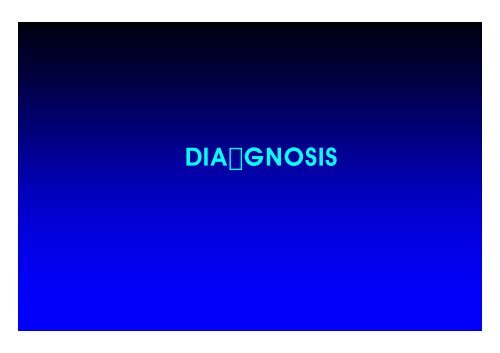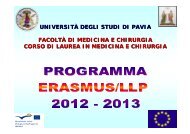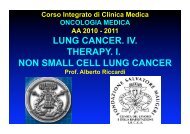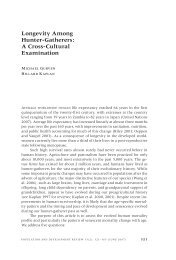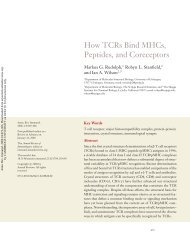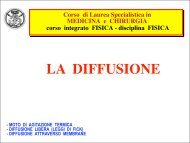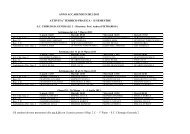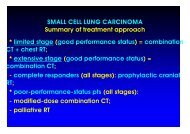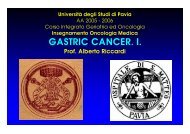AA.Gastric C II 06. ppt
AA.Gastric C II 06. ppt
AA.Gastric C II 06. ppt
Create successful ePaper yourself
Turn your PDF publications into a flip-book with our unique Google optimized e-Paper software.
DIA GNOSIS
GASTRIC ADENOCARCINOMA<br />
Diagnosis. I.<br />
* double - contrast radiographic examination<br />
(detecting small lesions by improving mucosal<br />
details) = (old) simplest diagnostic procedure<br />
for evaluation of pts with epigastric complaints;<br />
- stomach distended during radiographic<br />
examinations (decreased distensibility may be<br />
the only indication of diffuse infiltrative<br />
carcinoma)
DOUBLE - CONTRAST RADIOGRAPHIC EXAMINATION
GASTRIC ADENOCARCINOMA<br />
Diagnosis. <strong>II</strong>. <strong>Gastric</strong> ulcers<br />
* early detected with radiography;<br />
- however, those appearing benign are a<br />
special problem = ? impossible to distinguish<br />
benign from malignant lesions (anatomic<br />
location of an ulcer, usually lessr curvature, is<br />
not in itself an indication of presence or<br />
absence of cancer)
GASTRIC<br />
ADENOCARCINOMA<br />
Diagnosis. <strong>II</strong>I.<br />
<strong>Gastric</strong> ulcers<br />
* pooling of barium in a<br />
posterior ulcer that<br />
extends beyond lesser<br />
curve margin;<br />
- distortion of<br />
uninterrupted mucosal<br />
folds of stomach (drawn<br />
in towards ulcer)
GASTRIC ADENOCARCINOMA<br />
Diagnosis. IV. Gastroscopy<br />
* gastroscopic biopsy and brush cytology<br />
mandatory for pts with a gastric ulcer;<br />
- to identify malignant gastric ulcers before they<br />
penetrate into surrounding tissues (rate of cure of<br />
lesions limited to mucosa or submucosa > 80%);<br />
- as deep as possible, due to submucosal location<br />
of lymphoid tumors (GC difficult to distinguish<br />
clinically or radiographically from gastric<br />
lymphomas) and gastrointestinal stromal tumors<br />
(GISTs)
GASTRIC ADENOCARCINOMA<br />
Diagnosis. V. Gastroscopy<br />
* some physicians believe that gastroscopy is<br />
not mandatory if radiographic features are<br />
typically benign, if complete healing can be<br />
visualized by x - ray within 6 wks, and if a follow<br />
- up contrast radiograph shows normal<br />
appearance several mos later
GASTROSCOPY. I.
GASTROSCOPY. <strong>II</strong>.
GASTROSCOPY. <strong>II</strong>I.
GASTROSCOPY. IV.
GASTROSCOPY. V.
ENDOSCOPIC<br />
ULTRASOUND. I.<br />
* positioning of<br />
ecographic endoscopic<br />
transducer [submucosal<br />
gastric mass (A) and<br />
duodenum (B)];<br />
* water - filled balloon<br />
around transducer<br />
creates an acustic<br />
interfacies with area to<br />
be examined (with<br />
reducing air’s<br />
interference)
ENDOSCOPIC ULTRASOUND. <strong>II</strong>.<br />
* positioning of ecographic endoscopic transducer in gastric<br />
antrum;<br />
- normal gastric wall with alteranting dark (hipoecoic) and clear<br />
(hiperecoic) layers, histologically correlated (right) with mucosa,<br />
submucosa, muscularis propria and serosa or adventitia
ENDOSCOPIC ULTRASOUND. <strong>II</strong>I.<br />
Adenocarcinoma of esophagus<br />
endoscopic US of esophageal adenocarcinoma:<br />
circumferential, thick tumor mass around transductor [on the<br />
left, invading adipose periesophageal tissue and (anechogen)<br />
discendent aorta]
ENDOSCOPIC ULTRASOUND. IV.<br />
<strong>Gastric</strong> lipoma<br />
gastric lipomas: endoscopy (left): smooth contour masses;<br />
endoscopic US (right): hypoechoic mass in submucosa<br />
(mucosa and muscularis propria are normal)
ENDOSCOPIC ULTRASOUND. V.<br />
<strong>Gastric</strong> cancer confined to mucosa
ENDOSCOPIC ULTRASOUND. VI.<br />
<strong>Gastric</strong> cancer penetrating through wall of stomach<br />
TU = gastric tumor; PV = portal vein; SV = splenic vein
ENDOSCOPIC ULTRASOUND. V<strong>II</strong>.<br />
<strong>Gastric</strong> cancer invading pancreas<br />
TU = gastric tumor; PV = portal vein; LN = lymph node
DISSEMINATION
GASTRIC ADENOCARCINOMA<br />
Dissemination. I.<br />
* by direct extension through gastric wall to perigastric<br />
tissues (occasionally adhering to adjacent organs such<br />
as pancreas, colon or liver);<br />
- via lymphatics to intraabdominal (frequent) and<br />
supraclavicular lymph nodes (Troisier’ sign);<br />
- by seeding of peritoneal surfaces [metastatic<br />
nodules to ovary (Krukenberg's tumor), periumbilical<br />
region ("Sister Mary Joseph node") or peritoneal cul-desac<br />
(Blumer's shelf)];<br />
- malignant ascites;<br />
- hematogenous spread (more frequently to liver)
GASTRIC<br />
ADENOCARCINOMA<br />
Dissemination. <strong>II</strong>.
GASTRIC ADENOCARCINOMA<br />
Dissemination. <strong>II</strong>I. Bone marrow involvement
STAGING
GASTRIC ADENOCARCINOMA<br />
TNM: PRIMARY TUMOR<br />
- TX: primary tumor cannot be assessed;<br />
- T0: no evidence of primary tumor;<br />
- Tis: carcinoma in situ = intraepithelial tumor without<br />
invasion of lamina propria;<br />
- T1: tumor invades lamina propria or submucosa;<br />
- T2: tumor invades muscularis propria or subserosa;<br />
- T3: tumor penetrates serosa (visceral peritoneum)<br />
without invading adjacent structures;<br />
- T4: tumor invades adjacent structures
GASTRIC ADENOCARCINOMA<br />
TNM: PRIMARY TUMOR. I.<br />
- TX: primary tumor cannot be assessed;<br />
- T0: no evidence of primary tumor;<br />
- Tis: carcinoma in situ = intraepithelial tumor without invasion of<br />
lamina propria;<br />
- T1: tumor invades lamina propria or submucosa;<br />
- T2: tumor invades muscularis propria or subserosa*<br />
[* T2 = tumor penetrates muscularis propria with extension to<br />
gastrocolic or gastrohepatic ligaments or to greater or lesser<br />
omentum without perforation of visceral peritoneum covering<br />
these structures (with perforation of visceral peritoneum covering<br />
gastric ligaments or omentum, tumor is classified T3)]
TNM FOR GASTRIC ADENOCARCINOMA<br />
TNM: PRIMARY TUMOR. <strong>II</strong>.<br />
- T3: tumor penetrates serosa (visceral peritoneum)<br />
without invading adjacent structures**;<br />
- T4: tumor invades adjacent structures, including<br />
spleen, transverse colon, liver, diaphragm, pancreas,<br />
abdominal wall, adrenal gland, kidney, small intestine<br />
and retroperitoneum<br />
[** intramural extension to duodenum or esophagus<br />
is classified by depth of greatest invasion in any of<br />
these sites, including stomach]
TNM FOR GASTRIC ADENOCARCINOMA<br />
TNM: PRIMARY TUMOR. <strong>II</strong>I.<br />
- Tis: carcinoma in situ =<br />
intraepithelial tumor without<br />
invasion of lamina propria;<br />
- T1: tumor invades lamina<br />
propria or submucosa;<br />
- T2: tumor invades muscularis<br />
propria or subserosa;<br />
- T3: tumor penetrates serosa<br />
(visceral peritoneum) without<br />
invading adjacent structures;<br />
- T4: tumor invades adjacent<br />
structures
GASTRIC ADENOCARCINOMA<br />
TNM: REGIONAL LYMPH NODES (LN*)<br />
NX: regional LN not assessed;<br />
N0: no regional LN metastasis;<br />
N1: metastasis in 1 - 6 regional LN;<br />
N2: metastasis in 7 - 15 regional LN;<br />
N3: metastasis in > 15 regional LN;<br />
* = perigastric nodes (along lesser and greater curvatures) and<br />
nodes located along left gastric, common hepatic, splenic and celiac<br />
arteries (for pN, lymphadenectomy specimen will contain at least 15<br />
LN);<br />
- involvement of other intra - abdominal lymph nodes (e.g.,<br />
hepatoduodenal, retropancreatic, mesenteric and para - aortic LN,<br />
classified as distant metastasis)
GASTRIC ADENOCARCINOMA<br />
TNM: REGIONAL LYMPH NODES<br />
* regional lymph nodes:<br />
- N1 = perigastric (along lesser and greater curvatures);<br />
- N2 = along left gastric artery, and<br />
- N3 = along common hepatic, splenic and celiac arteries;<br />
* metastatic lymphnodes (= metastases): other intra - abdominal<br />
lymph nodes (e.g., hepatoduodenal, retropancreatic, mesenteric,<br />
and para - aortic LN)
GASTRIC ADENOCARCINOMA<br />
Classification and anatomy of lymph node groups<br />
* N1 disease = involvement of<br />
perigastric LN along lesser or greater<br />
curvature (1 - 6) [1, right paracardial; 2,<br />
left paracardial; 3, lesser curvature; 4,<br />
greater curvature; 5, suprapyloric; 6,<br />
infrapyloric];<br />
* N2 - N3 disease = involvement of LN<br />
along celiac axis (N2) and its 3<br />
branches (N3) (7 -11) [7, left gastric<br />
artery; 8, common hepatic artery; 9,<br />
celiac artery; 10, splenic hilus; 11,<br />
splenic artery];<br />
* N4 disease = involvement of more<br />
distant LN (12 - 14) [12, hepatic<br />
pedicle; 13, retropancreatic; 14,<br />
mesenteric root; 15, middle colic<br />
artery; 16, para-aortic]
GASTRIC ADENOCARCINOMA<br />
TNM: DISTANT METASTASIS (M)<br />
MX: distant metastasis cannot be assessed;<br />
M0: no distant metastasis<br />
M1: distant metastasis
GASTRIC ADENOCARCINOMA<br />
AJCC stage subgrouping. I.<br />
Stage 0<br />
- Tis, N0, M0<br />
Stage IA<br />
- T1, N0, M0<br />
Stage IB<br />
- T1, N1, M0<br />
- T2, N0, M0<br />
Stage <strong>II</strong><br />
- T1, N2, M0<br />
- T2, N1, M0<br />
- T3, N0, M0
GASTRIC ADENOCARCINOMA<br />
AJCC stage subgrouping. <strong>II</strong>.<br />
Stage <strong>II</strong>IA<br />
- T2, N2, M0<br />
- T3, N1, M0<br />
- T4, N0, M0<br />
Stage <strong>II</strong>IB<br />
- T3, N2, M0<br />
Stage IV<br />
- T4, N1, M0<br />
- T1, N3, M0<br />
- T2, N3, M0<br />
- T3, N3, M0<br />
- T4, N2, M0<br />
- T4, N3, M0<br />
- any T, any N, M1
STAGING GASTRIC CANCER
TNM STAGING SYSTEM<br />
FOR GASTRIC CANCER
R0 = no residual tumor; R1 = microscopic residual tumor;<br />
R2 = macroscopic residual tumor
TREATMENT
SURGERY
GASTRIC ADENOCARCINOMA<br />
Treatment. I. Surgery<br />
* surgical removal of complete tumor +<br />
adjacent lymph nodes = only chance for cure;<br />
- possible in < 30% of pts;<br />
* in general:<br />
- subtotal gastrectomy = treatment of choice<br />
for pts with distal GC;<br />
- total or near - total gastrectomy for more<br />
proximal tumors
GASTRIC<br />
CARCINOMA<br />
Surgery
GASTRIC ADENOCARCINOMA<br />
Treatment. <strong>II</strong>. Surgery
GASTRIC ADENOCARCINOMA<br />
Treatment. <strong>II</strong>I. Total gastrectomy<br />
* with proximal cancers, all stomach is removed (total<br />
gastrectomy) and gullet is joined directly onto small bowel<br />
(Roux - en - Y reconstruction)
GASTRIC ADENOCARCINOMA<br />
Treatment. IV. Total gastrectomy
GASTRIC ADENOCARCINOMA<br />
Treatment. V. Esophagogastrectomy<br />
* left) with cancers near cardia, a part of gullet is also removed<br />
(esophagogastrectomy) and top portion of gullet is joined to small<br />
bowel (“Roux - en - Y” reconstruction);<br />
* right) sometimes, furthest third of stomach is kept and remaining<br />
oesophagus is joined onto remaining part of stomach
GASTRIC ADENOCARCINOMA<br />
Treatment. VI. Partial gastrectomy (Billroth I and <strong>II</strong>)<br />
* for cancers at distal<br />
stomach (connecting with<br />
duodenum) → partial<br />
gastrectomy, with sparing the<br />
valve (cardiac sphincter)<br />
between esophagus and<br />
stomach;<br />
- 2 different types of<br />
operation, i.e., Billroth I (for<br />
very small tumors in lower<br />
part of stomach, near<br />
pylorus) and Billroth <strong>II</strong>
GASTRIC ADENOCARCINOMA<br />
Treatment. V<strong>II</strong>. Partial gastrectomy (Billroth I)<br />
* partial gastectomy (Billroth I), for very small tumors in<br />
lower part of stomach (near pylorus) connecting with<br />
duodenum, with sparing valve (cardiac sphincter)<br />
between esophagus and stomach
GASTRIC ADENOCARCINOMA<br />
Treatment. V<strong>II</strong>I. Partial gastrectomy (Billroth I)
GASTRIC ADENOCARCINOMA<br />
Treatment. XI. Partial gastrectomy (Billroth <strong>II</strong>)<br />
* partial gastectomy (Billroth <strong>II</strong>), for major tumors in<br />
lower part of stomach (near pylorus) connecting with<br />
small bowel, still with sparing valve (cardiac sphincter)<br />
between esophagus and stomach
GASTRIC<br />
ADENOCARCINOMA<br />
Treatment. X<strong>II</strong>.<br />
Partial gastrectomy<br />
(Billroth I & <strong>II</strong>)
GASTRIC<br />
ADENOCARCINOMA<br />
Treatment. X<strong>II</strong>I.<br />
Complications of surgery. I.<br />
Dumping syndrome<br />
palpitations, diaphoresis,<br />
flushing, hunger (but early<br />
epigastric fullness),<br />
borborygmi, abdominal<br />
cramps, diarrhea
GASTRIC<br />
ADENOCARCINOMA<br />
Treatment. XIV.<br />
Complications of surgery. <strong>II</strong>.<br />
Ulcer<br />
Gastrocolic fistula
GASTRIC ADENOCARCINOMA<br />
Treatment. XV. Prognosis after surgery<br />
* adversely influenced by degree of tumor<br />
penetration into stomach wall, regional lymph<br />
node involvement, vascular invasion and<br />
abnormal DNA content (i.e., aneuploidy,<br />
occurring in most pts);<br />
- for < 30% of pts able to undergo a complete<br />
resection of GC, 5 - yr survival is 20% for distal<br />
tumors and < 10% for proximal tumors<br />
(recurrences occurs for ≥ 8 yrs after surgery)
GASTRIC ADENOCARCINOMA<br />
Treatment. XVI. Prognosis after surgery<br />
* survival according<br />
with ploidy and S phase fraction
GASTRIC ADENOCARCINOMA<br />
Treatment. XV<strong>II</strong>.<br />
* in absence of ascites or extensive hepatic or<br />
peritoneal metastases, even pts whose disease<br />
is believed incurable by surgery should be<br />
offered an attempt at resection of primary<br />
lesion (reduction of tumor bulk is best form of<br />
palliation, ↑ subsequent benefit of<br />
chemotherapy and / or radiation therapy, ?<br />
avoids “emergency” surgery)
RADIOTHERAPY
GASTRIC ADENOCARCINOMA<br />
Treatment. XV<strong>II</strong>I. Radiotherapy<br />
* GC is a radioresistant tumor (= achieving<br />
adequate control of primary tumor requires<br />
doses of external beam radiation exceeding<br />
tolerance of surrounding structures, such as<br />
bowel mucosa and spinal cord);<br />
- palliation of pain = major role of radiation<br />
therapy in pts with GC
CHEMOTHERAPY
GASTRIC ADENOCARCINOMA<br />
Treatment. XIX.<br />
Chemotherapy for advanced disease<br />
* combinations of cytotoxic drugs to pts with<br />
advanced GC reduces > 50% measurable tumor mass<br />
in 30 - 50% of cases ("partial response"), with significant<br />
clinical benefit;<br />
- drug combinations generally include 5 - FU<br />
(variously with doxorubicin, mitomycin - C, cisplatin,<br />
high doses of methotrexate, irinotecan and<br />
oxaliplatin);<br />
* despite response, complete disappearances of<br />
tumor masses uncommon, partial responses transient<br />
and overall impact of multidrug therapy on survival<br />
doubtful
GASTRIC ADENOCARCINOMA<br />
Treatment. XXX. Adjuvant chemotherapy<br />
* prophylactic (i.e., adjuvant) chemotherapy<br />
following complete resection of GC (as a<br />
mean of eradicating clinically undetectable<br />
micrometastases and improving potential for<br />
cure) possibly ?unsuccessful:<br />
→ adjuvant treatment [as well as of<br />
preoperative ("neoadjuvant")] chemotherapy<br />
still investigational
GASTRIC ADENOCARCINOMA<br />
Treatment. XXXI. Metanalysis of adjuvant chemotherapy
GASTRIC ADENOCARCINOMA<br />
Treatment. XXX<strong>II</strong>. Adjuvant chemotherapy<br />
* no survival advantage over classic 5 - FU alone in pts<br />
randomized to either 5 - FU alone, or 5 - FU, doxorubicin and<br />
cisplatin or 5 - FU, doxorubicin and methyl CCNU with triazinate<br />
(Cullinan et al 1994)
RADIO - CHEMOTHERAPY
GASTRIC ADENOCARCINOMA<br />
Treatment. XXX<strong>II</strong>I. Adjuvant radio - chemotherapy. I.<br />
* radiation therapy alone after a complete<br />
resection does not prolong survival;<br />
- however, survival is prolonged when 5 -<br />
fluorouracil (5 - FU) is given in combination<br />
with radiation therapy (5 - FU functions as a<br />
radiosensitizer?)
GASTRIC ADENOCARCINOMA<br />
Treatment. XXXIV.<br />
Adjuvant radio - chemotherapy. <strong>II</strong>.<br />
Immagine 4
GASTRIC ADENOCARCINOMA<br />
Treatment. XXXV.<br />
Adjuvant<br />
radio - chemotherapy. <strong>II</strong>I.<br />
irradiation fields
GASTRIC ADENOCARCINOMA<br />
XXXVI. Major toxicities (≥ G3) of adjuvant<br />
radio - chemotherapy. IV.<br />
* hematologic (54%);<br />
* GI (33%);<br />
* flu - like (9%);<br />
* infection (6%);<br />
* neurological (4%);<br />
* cardiovascular (4%);<br />
* pain (3%);<br />
* hepatic (1%), respiratory (1%) & skin (1%)
GASTRIC ADENOCARCINOMA<br />
Treatment. XXXV<strong>II</strong>.<br />
Adjuvant<br />
radio-chemotherapy. V.<br />
local failures<br />
in surrounding<br />
organs or tissues;<br />
* = lung metastases;<br />
+ = liver metastases
GASTRIC LYMPHOMA
GASTRIC LYMPHOMA<br />
* < 15% of gastric<br />
malignancies and<br />
2% of all lymphomas;<br />
- however, stomach<br />
is most frequent<br />
extranodal location<br />
for lymphoma, and<br />
- gastric lymphoma<br />
↑ in frequency during<br />
the past 20 yrs
GASTRIC LYMPHOMA<br />
* infection with H. pylori (also associated with<br />
development of GC) ↑ risk for gastric<br />
lymphoma [especially mucosa - associated<br />
lymphoid tissue (MALT) lymphomas)
GASTRIC LYMPHOMA<br />
Clinical and radiologic features<br />
* difficult to distinguish from GC: both<br />
- in 6th decade of life;<br />
- epigastric pain, early satiety, and generalized<br />
fatigue;<br />
- at contrast radiographs, usually ulceration with a<br />
ragged, thickened mucosal pattern (less frequently,<br />
bulky ulcerated lesion localized in corpus or antrum<br />
or a diffuse process spreading throughout entire<br />
gastric submucosa)
GASTRIC LYMPHOMA<br />
Diagnosis<br />
* by deep biopsy at time of gastroscopy (or at<br />
laparotomy);<br />
- usually, B - cell non - Hodgkin's lymphoma;<br />
- from well - differentiated, superficial processes<br />
(mucosa - associated lymphoid tissue, MALT) to<br />
high - grade, large cell lymphomas;<br />
- initially spreads to regional lymph nodes (often<br />
to Waldeyer's ring) and may disseminate;<br />
- staged like other lymphomas
C<br />
D<br />
GASTRIC MALT LYMPHOMA<br />
Diagnosis<br />
C) cytokeratin+ cells, lympho -<br />
epithelial lesions and monocytoid<br />
infiltrate (not neoplastic);<br />
D) neoplastic large cells expressing<br />
mainly B cell marker CD20;<br />
E) proliferative rate by Ki67 (MIB1)<br />
E
GASTRIC LYMPHOMA<br />
Treatment. I.<br />
* need for a correct diagnosis because<br />
gastric lymphoma is a far more treatable than<br />
GC;<br />
- antibiotic treatment to eradicate H. pylori<br />
infection → regression of ~ 50% of gastric MALT<br />
lymphomas (= to be considered before<br />
surgery, radiation therapy or chemotherapy)
GASTRIC LYMPHOMA<br />
Treatment. <strong>II</strong>.<br />
* chemotherapy alone largely substitutes<br />
surgery in pts with CT evidence of nodal<br />
involvement or more widespread disease
GASTRIC LYMPHOMA<br />
Treatment. <strong>II</strong>I.<br />
* in pts with localized high - grade NHL<br />
(subtotal gastrectomy followed by)<br />
combination chemotherapy allows 5 - yr<br />
survival rates of 40 - 60%;<br />
- questioned radiation therapy to abdomen<br />
following surgical resection (most recurrences<br />
develop at sites distant from epigastrium =<br />
outside radiation treatment fields)


